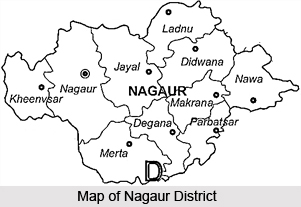 Administration of Nagaur district is carried out by the District Collector. Nagaur district is one of the biggest districts in the state of Rajasthan. The District Collector is aided in the exercise of his functions by two Additional District Magistrates.
Administration of Nagaur district is carried out by the District Collector. Nagaur district is one of the biggest districts in the state of Rajasthan. The District Collector is aided in the exercise of his functions by two Additional District Magistrates.
Sub Division Offices
There are nine Sub-Divisional Officers (SDOs) who work at the Sub Division level. They have been appointed with a view to providing administrative support at the local level. There are a sum total of nine divisions in the district of Nagaur. These are: Nagaur, Jayal, Merta, Degana, Deedwana, Ladnun, Parbatsar, Makarana and Nawa.
Tehsils
There are ten tehsil headquarters in this district. Each one of the tehsils has a Tehsildar who acts as the administrative officer. This Tehsildar works in accordance with the land-record system to serve rural farmers and land-holders. The tehsils of the district are Nagaur, Khivnsar, Jayal, Merta, Degana, Deedwana, Ladnun, Parbatsar, Makarana and Nawa. A tehsil contains a number of Patwar-Mandals, each of which has a `Patwari` to serve the landholders and farmers at the village level. There are seven Additional/Sub tehsils namely - Kuchaman, Deh, Maulasar, Sanju, Riyan, Bherunda and Peelwa.
Blocks (Panchayat Samitis)
Nagaur district is divided into 11 blocks (Panchayat Samitis) which are the developmental units. Each block has a BDO (Block Development Officer) to serve as the representives of the district administration in the rural areas. The blocks are Nagaur, Mundwa, Jayal, Merta, Riya Badi, Degana, Deedwana, Ladnun, Parbatsar, Makarana and Kuchaman. Various development works and projects at the rural level (Gram Panchayat Level) are run through Block offices. One Gram Sevak is appointed at each Gram Panchayat to keep record of the development works and to project required development works. Gram Sabha (Village Meetings) is organized at fixed intervals to discuss about development of villages. There are 461 Gram Panchayats in the district.
This is the systematised set up of administration as it is carried out in the district of Nagaur.
This article is a stub. You can enrich by adding more information to it. Send your Write Up to content@indianetzone.com



















